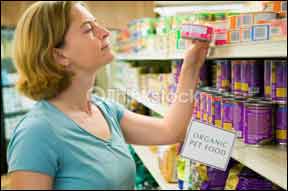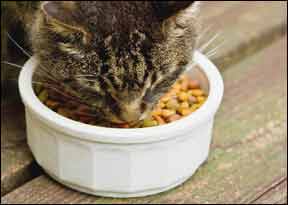Unless he’s acting in a TV commercial, your cat isn’t really able to ask for his favorite brand of food by name. If he’s like most feline companions, he’s dependent on you to bring home a can or package of food that will taste good, and also be safe and wholesome. He will also rely on you to feed the correct amount to meet his nutritional needs. To do that, you’re going to have to understand cat food labels.

288
A Lot of Information. Start by putting on your reading glasses! In order to cram all of the essential information onto a label, the type size will be very tiny. The biggest type will always identify the brand. Next in size will be the line that tells you what flavor of food is in the container. Each designation must conform to standards set by the Association of American Feed Control Officials (AAFCO), a group of state feed-control officials. For example, if the label says “chicken dinner,” the product must contain at least 25 percent chicken, not counting added water.
AAFCO also requires that each label bear a nutritional guarantee. For example, the guarantee may state that the product provides complete and balanced nutrition for a specific life stage, such as growth and/or maintenance. AAFCO also requires a statement about how the guarantee was validated — for example, by feeding trials in cats.
Labels must also contain directions on how much to feed cats for the life stage for which the food is approved. This is an important part of the label. By comparing different products, you will be able to determine the relative price of the food based upon how much you will need to feed your cat.
The ingredients list is the most daunting element on a label: It is the wordiest part and most likely to contain unfamiliar names. The best place to start is with the knowledge that the U.S. Food and Drug Administration (FDA) regulates pet foods to ensure that they do not contain ingredients that have a risk for harming your cat. According to AAFCO recommendations, ingredients are required to be listed in descending order of predominance by wet weight as added to the product. AAFCO also requires that the product must be identified as pet food, that a net quantity or weight statement be on the front of the package and that the manufacturer’s, packer’s or distributor’s name and place of business be on the package, as well. There is no legal definition of the term “premium” or “super-premium.”

288
The Mysterious By-Product. But what do the contents of the can actually mean? For example, if your see wheat gluten or soy protein on the ingredients list, you probably don’t need an explanation. But not everyone knows what meat and poultry by-products mean. AAFCO defines by-products as the nonrendered, clean parts of an animal, other than skeletal muscle. (Skeletal muscle is what we humans usually buy in the store as meat to consume.) This includes, but is not limited to, lungs, spleen, kidneys, brain, liver, blood, bone, partially defatted fatty tissue, as well as stomachs and intestines freed of their contents.
If spleen sounds unappealing to you, remember that cats have their own idea of what is and isn’t gourmet fare! If you object to feeding your cat by-products — and some cat owners do — you can consider buying a premium-quality food brand that does not use by-products. To be certain, however, check the label.
Because insufficient amounts of amino acids (including taurine) and vitamins — such as vitamins E and A — can have serious consequences on a cat’s health, taurine and vitamins are among the ingredients added to most cat foods. Vitamin E deficiency, for example, can result in an extremely painful condition known as steatitis, an inflammation of the fatty tissue. A diet with inadequate quantities of taurine can result in a form of heart disease or blindness. Most ingredient lists show one or more preservatives or antioxidants (to prevent oxidation of polyunsaturated fats) in the cat food. These not only give the food a longer shelf life, but may also serve as anticancer agents and prevent food spoilage.
Another label section starts with the words “Guaranteed Analysis” — this shows the minimum percentages of protein and fat, and the maximum percentages of fiber and water in the product. Compare a few brands. Cats do well on high-protein diets, and you may find that some brands give you more protein for your money. Comparisons should be made on a dry-matter basis, because canned foods contain up to 80 percent moisture, whereas dry food may be less than 10 percent moisture. Thus, dry and canned food can appear to be quite different in their “guaranteed analysis.”
A final element is the manufacturer’s name and address. This not only identifies the company responsible for the quality and safety of the food, but also gives you a reliable source for any additional information that might be needed. The manufacturer generally has a nutrient reference chart available for the food, which will list nutrient density and caloric distribution. Call the manufacturer to get one.
Nutritionists recommend that the package have a “best used by” or expiration date, and a satisfaction guarantee that states exactly what the company will do for you if you report that you are not satisfied with their product.



